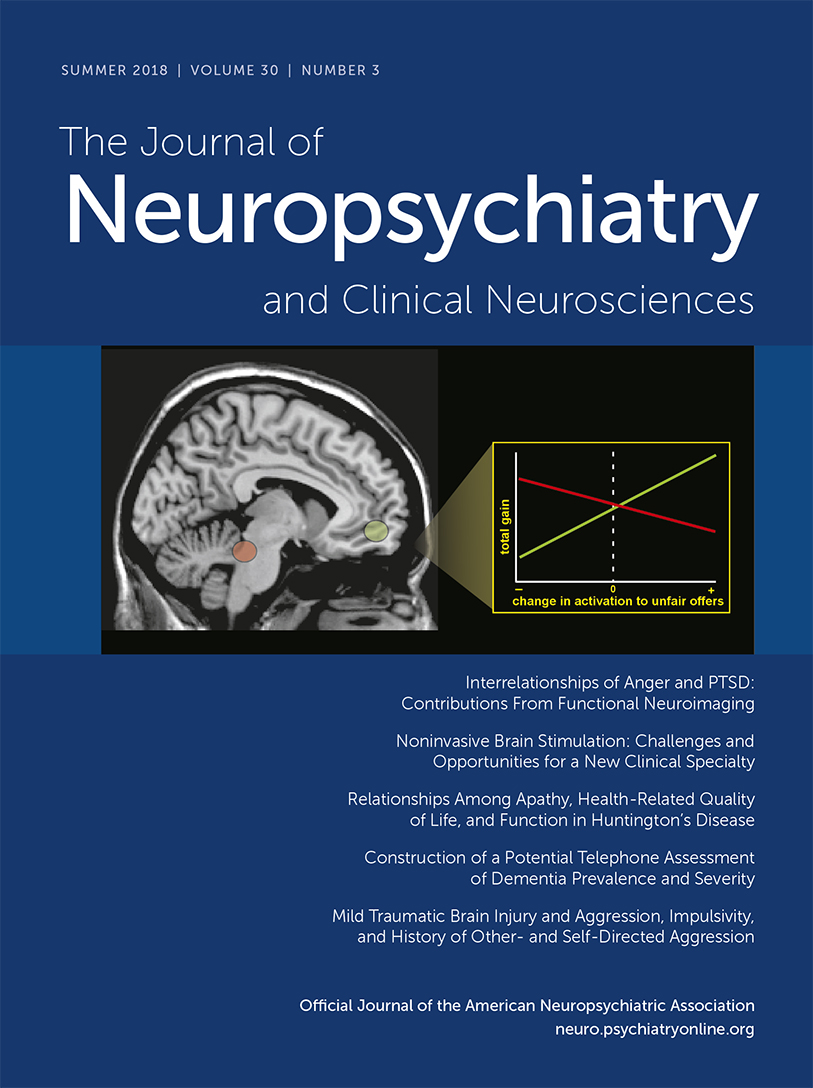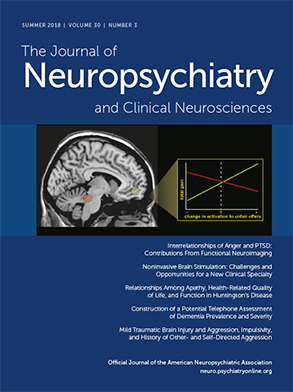There is growing recognition that anger can have both negative and positive roles in posttraumatic stress disorder (PTSD).
13–17 In addition to being a potential symptom, anger has been implicated as a risk factor for developing PTSD and as contributing to poorer functional outcomes (e.g., relationships, quality of life, treatment efficacy). Trauma-related anger may also contribute to post traumatic growth. Thus, interventions targeting dysfunctional anger expression and/or management have potential to improve both mental and physical health outcomes for individuals with PTSD. These and other findings indicate the importance of understanding the neurobiology of both adaptive and maladaptive anger.
Anger can be either adaptive (e.g., positive, healthy, functional) or maladaptive (e.g., negative, unhealthy, dysfunctional).
13,18–25 Anger is considered adaptive when it is elicited and expressed appropriately, maladaptive when it is elicited and/or expressed inappropriately (e.g., triggered too easily, expressed more strongly than warranted by the situation). The adaptive value of anger has been described in many ways: helping organisms respond to challenges in a more flexible way; signaling that unfairness and/or injury has occurred to promote active negotiation to achieve resolution; surmounting an obstacle to achieving a desired goal. In these examples the value of anger is to motivate expenditure of effort to remove an obstacle. Studies utilizing a variety of role-playing situations involving negotiations (landlord and tenant, terms of class project, seller and buyer) have demonstrated that moderate use of anger-conveying behaviors (e.g., confrontational tone, raising voice) facilitated gain during negotiations.
26,27 In contrast, expression of no anger or intense anger were both detrimental. Another study found that individuals with higher levels of emotional intelligence were more likely to prefer the situationally useful emotion rather than a more pleasant emotion (e.g., anger rather than happiness in confrontational situations).
28 Possibly related, a study that utilized daily diaries reported that individuals differed on the affective valence (negative or positive) associated with anger episodes.
29 The authors of that study suggested that individual differences in the motivational direction of anger (whether it is experienced as promoting approach or avoidance) may be relevant to maladaptive anger in psychiatric disorders. Another study reported that individuals higher in trait anger (trait anger subscale from the State-Trait Anger Expression Inventory [STAXI]) were biased toward approaching rather than avoiding angry faces.
30 Trait anger is generally believed to be a stable dispositional characteristic of an individual, and high trait anger is thought to indicate higher likelihood of experiencing and expressing anger.
31 However, studies using diary methodology in healthy individuals to capture angering events have reported that trait anger is at most modestly predictive of the day-to-day experience of anger.
31,32An aspect of the study of anger highly relevant to the results of functional imaging studies is the wide range of stimuli that have been utilized as the anger condition.
19,21,22,24,33 Angry faces are the most common, either simply viewing or with an associated task. Depending on the context, a variety of internal processing might be evoked in addition to anger recognition, such as thinking about being angry, experiencing an emotional response (e.g., anger, fear, anxiety), and/or suppressing an emotional response. The diverse stimuli that have been used to induce the state of being angry and/or to elicit anger-related behavior also are likely to differ in the internal processing evoked. In the context of PTSD, the DSM-5 makes a clear distinction between feeling angry (criterion D) and anger-induced behaviors (criterion E).
34Multiple functional imaging studies using a diversity of analytic approaches have reported that different basic emotions (e.g., anger, fear, happiness) are associated with specific patterns of neural activation.
1,18,24,35–39 Two meta-analyses that used activation likelihood estimation (ALE) reported relatively similar areas of convergence for anger-related stimuli.
1,37 Only a few of the included functional imaging studies were of state anger, as facial expressions were the most commonly used anger stimuli. The meta-analysis that compared activations when all studies of anger were included to only studies using faces as stimuli (10/16) found that more than half of activations (8/13) were still significant (
Figure 1).
1 A study in healthy individuals reported increased functional connectivity (functional MRI [fMRI]) during viewing of angry faces (compared with neutral) between the amygdala and a set of region that overlapped very little with the meta-analyses (
Figure 1).
2 Two recent fMRI studies compared groups of males (community, military veterans) divergent on trait anger (STAXI-revised [STAXI-2]) while viewing emotional pictures.
4,5 Both studies reported that high trait anger was associated with higher activations in multiple areas (
Figure 2).
4,5 The group that compared military veterans with and without problematic anger and aggression also assessed functional connectivity (seed-based) of the amygdala and dorsal anterior cingulate cortex (dACC).
5 Although there were no task-related changes in functional connectivity using amygdala seeds, connectivity of the dACC with amygdala was higher in veterans with problematic anger during processing of negative images.
The neural activations associated with state anger have been evaluated in several fMRI studies that included some form of emotion generation or induction (e.g., imagery based on personal script, music, films, nonphysical provocation by opponent).
3,10,11,40–42 Functional MRI studies that used pattern classification identified combinations of areas that predicted the emotion experienced (e.g., anger, disgust, fear, happiness) both within and across individuals at well above chance levels.
3,40–42 The regions that predicted state anger were mostly different from the regions identified in the meta-analyses of functional imaging studies presented previously (
Figure 1).
3 A series of studies from one group used two methods of provoking state anger during fMRI (Ultimatum Game [UG] modified to have multiple negotiation rounds with an intentionally obnoxious opponent, anger-provoking films) in an effort to identify imaging biomarkers of vulnerability and/or resilience to military-training related stressors.
6–9 Functional MRI studies were performed prior to training. Traumatic stress symptoms (Post-Traumatic Stress Disorder Check-List–Military [PCL-M]) were measured at the end of a year of intense military combat training. Level of success in playing the modified UG was measured by amount of money gained. Poorer performance on the modified UG (low gain) was associated with higher symptoms at the end of training. The high gain and low gain groups did not differ on trait anger or trait anxiety. However, the high gain group reported lower levels of anger during provocation, suggesting better self-regulation of emotion. Higher global functional connectivity of the amygdala (resting-state fMRI) prior to anger induction was negatively correlated with level of anger following provocation. Performance was positively correlated with activation within the orbitofrontal cortex and slower skin conductance response (SCR) and negatively correlated with activation in a brainstem area that includes the locus coeruleus (
Cover and Figure 3).
6 Locus coeruleus is one of the areas where startle-related activation is greater in subjects with PTSD.
12 Greater activation within the orbitofrontal cortex was also reported in an fMRI study that used a different anger-provoking game in healthy males.
10 The authors speculated that this indicated greater self-regulation of emotion. Another fMRI study in healthy individuals used personal script-evoked imagery to induce anger.
11 Activation increased within the amygdala during anger induction, followed by activation within the orbitofrontal cortex during anger imagery that was negatively correlated (trend level) with self-reported anger. Greater habitual use of cognitive reappraisal for self-regulation of emotion was negatively associated with amygdala activations during viewing of negative images in trauma exposed military veterans regardless of PTSD status.
43 In contrast, greater treatment-related symptom reductions in veterans with combat-related PTSD correlated with increased activations in the amygdala and several medial prefrontal cortex regions to angry (but not neutral or fearful) faces.
44Changes in arousal and reactivity, including angry outbursts, are characteristic symptoms of PTSD.
34 Anger and PTSD are positively correlated and this correlation is more significant in military than in civilian populations.
15,45 Several studies have explored the interactions between anger and PTSD in active duty soldiers. Higher trait anger prior to deployment predicted PTSD symptoms at 2 months after return from deployment.
46 However, trait anger at that time did not predict PTSD symptoms at 9 months, supporting trait anger as a PTSD risk factor.
46 The relationship between PTSD and aggressive behaviors at 3 months postdeployment was mediated by high trait anger, indicating the importance of anger as a therapeutic target.
47 There is evidence that positive aspects of anger (e.g., source of motivation) may be emphasized in the military context.
13 At 4 months postdeployment, PTSD symptom scores were positively correlated with anger reaction scores (surrogate measure for trait anger); 21% of the group indicated that they found anger to be helpful often or very often.
13 Three months later, this had decreased to 7%. However, perception of anger as helpful was associated with greater physical and mental health difficulties, indicating that it is not a positive influence in the postdeployment context. The authors suggested the clinical value in helping individuals recognize situations where anger is not beneficial and to improve emotion regulation skills.
13 A study in veterans also reported that PTSD symptoms predicted occurrence of anger-related symptoms (e.g., irritable affect), but anger did not predict occurrence of PTSD symptoms.
48 A strong interest in receiving treatment for problematic anger was noted in a study that included veterans with PTSD.
49There are multiple approaches that have demonstrated the value of treating anger in the context of PTSD, although most studies are small.
15,50 Anger management programs can improve anger management skills and provide lasting benefits.
15,51,52 An analysis of mechanism(s) of action indicated that improvements in skills related to arousal reduction/calming were most predictive of symptom reductions.
53 This suggests that recently developed mindfulness-based interventions for veterans with combat-related PTSD may also decrease anger symptoms.
44,54 PTSD treatments, such as cognitive behavioral therapies, can also reduce problematic anger.
15 A clinical case series in active duty military with PTSD and problematic anger reported that an individually delivered cognitive behavioral therapy based anger management intervention resulted in clinically significant reductions in symptoms of anger (6/8 cases) and PTSD (5/8 cases).
55 A small randomized controlled trial in veterans with combat-related PTSD and problematic anger reported that prolonged exposure therapy and affect regulation therapy had similar efficacy.
56 Interventions designed to reduce intimate partner violence also show promise.
15,23In conclusion, there is considerable evidence that anger and PTSD are highly interrelated. However, the nature of the interactions is complex and not fully understood. Functional imaging studies are beginning to examine underlying neural correlates of many aspects. Of particular clinical value will be studies that elucidate mechanisms underlying successful interventions.




